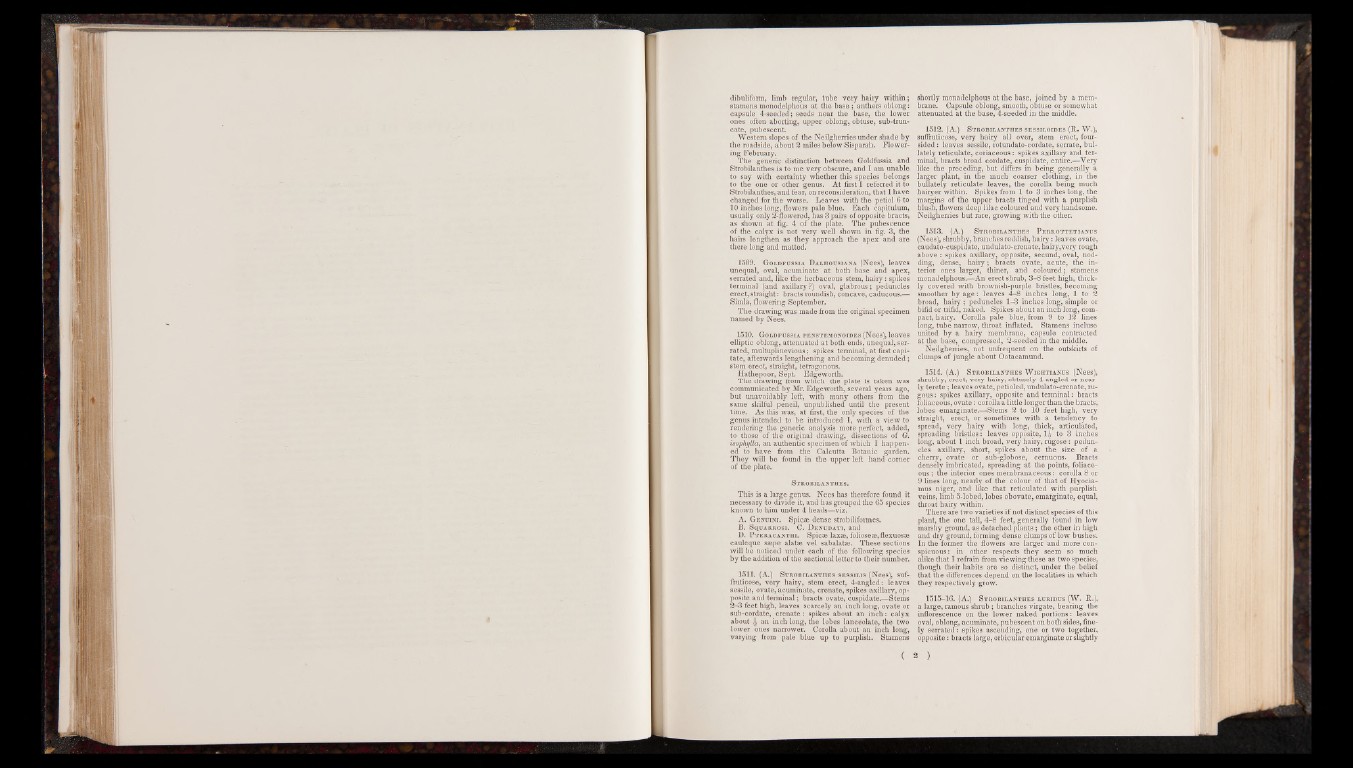
dibuliform, limb regular, tube very hairy within;
stamens monodelphous at the base ; anthers oblong:
capsule 4-seeded; seeds near the base, the lower
ones often aborting, upper oblong, obtuse, sub-truncate,
pubescent
Western slopes of the Neilgherries under shade by
the roadside, about 2 miles below Sisparah. Flowering
February.
The generic distinction between Goldfussia and
Strobilanthes is to me very obscure, and I am unable
to say with certainty whether this species belongs
to the one or other genus. At first 1 referred it to
Strobilanthes, and fear, on reconsideration, that I have
changed for the worse. Leaves with the petiol 6 to
10 inches long, flowers pale blue. Each capitulum,
usually only 2-flowered, has 3 pairs of opposite bracts,
as shown at fig. 4 of the plate. The pubescence
of the calyx is not very well shown in fig. 3, the
hairs lengthen as they approach the apex and are
there long and matted.
1509. Goldfussia Dalhousiana (Nees), leaves
unequal, oval, acuminate at both base and apex,
serrated and, like the herbaceous stem, hairy: spikes
terminal (and axillary ?) oval, glabrous; peduncles
erect, straight: bracts roundish, concave, caducous.—
Simla, flowering September.
The drawing was made from the original specimen
named by Nees.
1510. Goldfussia penstemonoides (Nees), leaves
elliptic oblong, attenuated at both ends, unequal, serrated,
multuplinevious; spikes terminal, at first capitate,
afterwards lengthening and becoming denuded;
stem erect, straight, tetragonous.
Hathepoor, Sept. Edgeworth.
The drawing from which the plate is taken was
communicated by Mr. Edgeworth, several years ago,
but unavoidably left, with many others from the
same skilful pencil, unpublished until the present
time. As this was, at first, the only species of the
genus intended to be introduced I, with a view to
rendering the generic analysis more perfect, added,
to those o f the original drawing, dissections of G.
isophylla, an authentic specimen of which I happened
to have from the Calcutta Botanic garden.
They will be found in the upper left hand corner
of the plate.
Strobilanthes.
This is a large genus. Nees has therefore found it
necessary to divide it, and has grouped the 65 species
known to him under 4 heads—viz.
A. Genuini. Spices dense strobiliformes.
B. Squarrosi. C. Denudati, and
D. Pteracanthi. Spicee lax<e, folioseee, flexuosee
cauleque seepe alatas vel sabalatee. These sections
will be noticed under each of the following species
by the addition of the sectional letter to their number.
1511. (A.) Strobilanthes sessilis (Nees), suf-
fruticose, very hairy, stem erect, 4-angled: leaves
sessile, ovate, acuminate, crenate, spikes axillary, opposite
and terminal; bracts ovate, cuspidate.—Stems
2 -3 feet high, leaves scarcely an inch long, ovate or
sub-cordate, crenate: spikes about an in ch : calyx
about ^ an inch long, the lobes lanceolate, the two
lower ones narrower. Corolla about an inch long,
varying from pale blue up to purplish. Stamens
shortly monadelphous at the base, joined by a membrane.
Capsule oblong, smooth, obtuse or somewhat
attenuated at the base, 4-seeded in the middle.
1512. (A.) Strobilanthes sessiloides (R. W.),
suffruticose, very hairy all over, stem erect, foursided
: leaves sessile, rotundato-cordate, serrate, bul-
lately reticulate, coriaceous: spikes axillary and terminal,
bracts broad cordate, cuspidate, entire.—Very
like the preceding, but differs in being generally a
larger plant, in the much coarser clothing, in the
buuately reticulate leaves, the corolla being much
hairyer within. Spikes from 1 to 3 inches long, the
margins of the upper bracts tinged with a purplish
blush, flowers deep lilac coloured and very handsome.
Neilgherries but rare, growing with the other.
1513. (A.) Strobilanthes Perrottetianus
(Nees), shrubby, branches reddish, hairy: leaves ovate,
caudato-cuspidate, undulato-crenate, hairy,very rough
ab o v e: spikes axillary, opposite, secund, oval, nodding,
dense, hairy; bracts ovate, acute, the interior
ones larger, thiner, and coloured; stamens
monadelphous.—An erect shrub, 3 -8 feet high, thickly
covered with brownish-purple bristles, becoming
smoother by a g e : leaves 4 -8 inches long, 1 to 2
broad, hairy; peduncles 1-3 inches long, simple or
bifid or trifid, naked. Spikes about an inch long, compact,
hairy. Corolla pale blue, from 9 to 12 lines
long, tube narrow, throat inflated. Stamens incluse
united by a hairy membrane, capsule contracted
at the base, compressed, 2-seeded in the middle.
Neilgherries, not unfrequent on the outskirts of
clumps of jungle about Ootacamund.
1514. (A.) Strobilanthes Wightianus (Nees),
shrubby, erect, very hairy, obtusely 4-angled or nearly
terete; leaves ovate, petioled, undulato-crenate, rugous
: spikes axillary, opposite and terminal: bracts
ioliaceous, ovate: corolla a little longer than the bracts,
lobes emarginate.—Stems 2 to 10 feet high, very
straight, erect, or sometimes with a tendency to
spread, very hairy with long, thick, articulated,
spreading bristles: leaves opposite, 1 | to 3 inches
long, about 1 inch broad, very hairy, rugose: peduncles
axillary, short, spikes about the size of a
cherry, ovate or sub-globose, cemuous. Bracts
densely imbricated, spreading at the points, foliace-
o u s; the interior ones membranaceous: corolla 8 or
9 lines long, nearly of the colour of that of Hyocia-
mus niger, and like that reticulated with purplish
veins, limb 5-lobed, lobes obovate, emarginate, equal,
throat hairy within.
There are two varieties if not distinct species of this
plant, the one tall, 4 -8 feet, generally found in low
marshy ground, as detached plants; the other in high
and dry ground, forming dense clumps of low bushes.
In the former the flowers are larger 'and more conspicuous:
in other respects they seem so much
alike that I refrain from viewing these as two species,
though their habits are so distinct, under the belief
that the differences depend on the localities in which
they respectively grow.
1515-16. (A.) Strobilanthes luridus (W. R.),
a large, ramous shrub; branches virgate, bearing the
inflorescence on the lower naked portions: leaves
oval, oblong, acuminate, pubescent on both sides, finely
serrated: spikes ascending, one or two together,
opposite: bracts large, orbicular emarginate or slightly